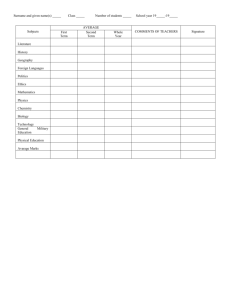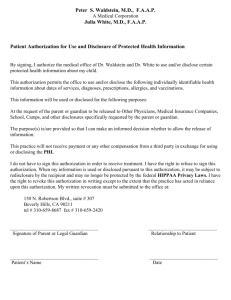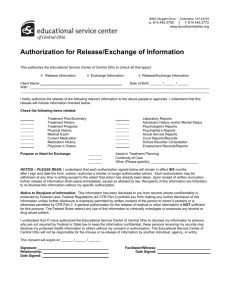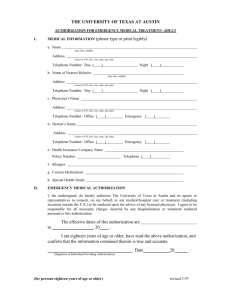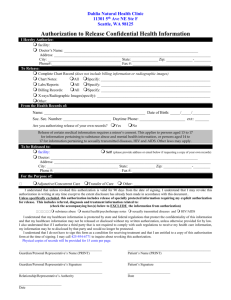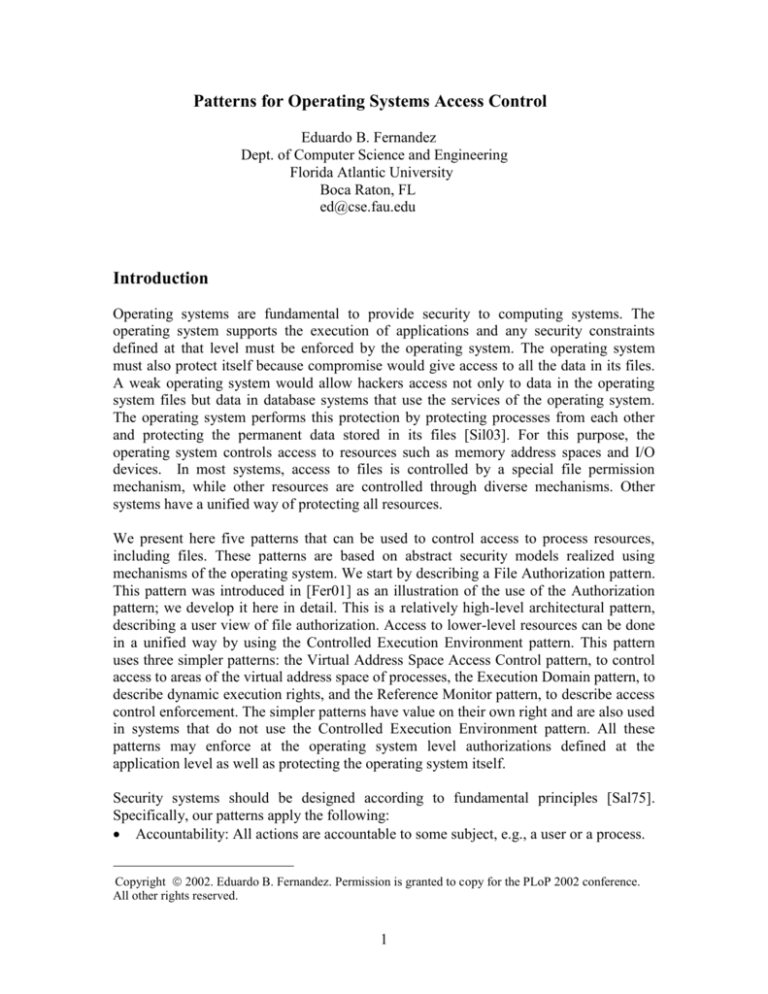
Patterns for Operating Systems Access Control
Eduardo B. Fernandez
Dept. of Computer Science and Engineering
Florida Atlantic University
Boca Raton, FL
ed@cse.fau.edu
Introduction
Operating systems are fundamental to provide security to computing systems. The
operating system supports the execution of applications and any security constraints
defined at that level must be enforced by the operating system. The operating system
must also protect itself because compromise would give access to all the data in its files.
A weak operating system would allow hackers access not only to data in the operating
system files but data in database systems that use the services of the operating system.
The operating system performs this protection by protecting processes from each other
and protecting the permanent data stored in its files [Sil03]. For this purpose, the
operating system controls access to resources such as memory address spaces and I/O
devices. In most systems, access to files is controlled by a special file permission
mechanism, while other resources are controlled through diverse mechanisms. Other
systems have a unified way of protecting all resources.
We present here five patterns that can be used to control access to process resources,
including files. These patterns are based on abstract security models realized using
mechanisms of the operating system. We start by describing a File Authorization pattern.
This pattern was introduced in [Fer01] as an illustration of the use of the Authorization
pattern; we develop it here in detail. This is a relatively high-level architectural pattern,
describing a user view of file authorization. Access to lower-level resources can be done
in a unified way by using the Controlled Execution Environment pattern. This pattern
uses three simpler patterns: the Virtual Address Space Access Control pattern, to control
access to areas of the virtual address space of processes, the Execution Domain pattern, to
describe dynamic execution rights, and the Reference Monitor pattern, to describe access
control enforcement. The simpler patterns have value on their own right and are also used
in systems that do not use the Controlled Execution Environment pattern. All these
patterns may enforce at the operating system level authorizations defined at the
application level as well as protecting the operating system itself.
Security systems should be designed according to fundamental principles [Sal75].
Specifically, our patterns apply the following:
Accountability: All actions are accountable to some subject, e.g., a user or a process.
Copyright 2002. Eduardo B. Fernandez. Permission is granted to copy for the PLoP 2002 conference.
All other rights reserved.
1
Need-to-know (least privilege): Subjects should get only the rights needed to perform
their functions.
Complete mediation: Every access request must comply with the defined security
controls.
Security mechanisms must follow also a security model and we have presented patterns
for the most important models [Fer01]. A basic security model pattern, applied here in
several ways, is the Authorization pattern (Figure 1). This pattern realizes a variation of
the access matrix model [Pfl97]. This pattern defines an abstract model and can be
applied to all the levels of the system. Subjects (active entities) are authorized to access
protection objects (files, resources) in specific ways (access types such as read, write,
execute) and possibly according to a data-dependent predicate. A copy flag indicates if a
right can be transferred. Two basic ways to implement the access matrix are:
Access Control Lists (ACLs), where each protection object carries a list of the
subjects authorized to access it and their access types.
Capabilities, that correspond to rows of the access matrix and where subjects carry
tickets or credentials that allow them to access objects in specific ways.
Subject
ID
*
AuthorizationRule
ProtectionObject
*
ID
Right
accessType
predicate
copyFlag
checkRights ( )
Figure 1. The Authorization pattern
An important extension of this model is Role-Based Access Control (RBAC) [San96],
used now in most operating systems and presented as a pattern in [Fer01, Yod97]. In an
RBAC system subjects are roles and users are assigned to roles according to their
functional tasks or needs and can implement a need-to-know policy, fundamental for
security. For convenience, in many systems users are grouped (for example, all those
working in a given project). Subjects thus may be users, groups, and roles. For operating
2
systems, subjects also include executing processes. Typically, for accountability reasons,
a process runs on behalf of a user, group, or role.
For example, the different members of a project may share the project files with different
rights, some may be allowed to read and write the files, while others may only read them.
When groups are used, rights are given to a group instead of to each individual user; that
is, all the users in a group have similar rights for a protected object, e.g., several
programmers may be allowed to modify a file. When we use roles in a project, we may
have roles such as project leader, developer, analyst, tester, technical writer. Several users
may be assigned to the same role and a given user may have more than one role.
The File Authorization pattern
Intent
Control access to files in an operating system. Authorized users are the only ones that can
use a file in specific ways.
Context
The users of operating systems need to use files to store permanent information. These
files can be accessed by different users from different workstations and access to the files
must be restricted to authorized users who can use them in specific ways. Because of the
needs of the institution, some (or all) of the files must be shared by these subjects. Use
cases for a file system include creation and deletion of files, opening and closing of files,
reading and writing files, copying files, etc. A subject has a home directory for each
authorized workstation, but the same home directory can be shared among several
workstations or among several subjects. The home directory is used to search the files for
which a subject has rights. Files are organized using directories, usually in a tree-like
structure of directories and files. This facilitates the search for specific files.
Example
Jim is an application programmer in a bank. He has a user account and some files in the
bank operating system. He realizes that the same system also stores files with customer
data. These files have no authorization controls. Jim reads several of these files and finds
customer information such as SSNs and credit card numbers. He uses this information to
charge some items bought at mail order shops.
Problem
Files may contain valuable information and access to them must be controlled carefully.
In several recent attacks, hackers obtained lists of credit card numbers by accessing
illegally customer data. Because files need to be shared, security becomes harder to
enforce.
Forces
We need to balance the following forces:
3
There may be different types of subjects, e.g., users, roles, and groups. The rights for
users in groups or roles are derived from the group or role rights (they are implicit
rights). Groups of groups are possible, which makes deducing access even harder. All
these subjects must be handled uniformly.
Subjects may be authorized to access files or directories, and to exercise their file
rights from specific workstations. To prevent illegal actions we may need ways to
apply these two types of authorization.
Each operating system implements file systems in a different way. We need to
abstract out implementation details.
Not all operating systems use workstations, groups, or roles. We need a modular
system where features not used can be cut easily from the model.
Solution
We apply the Authorization pattern first to describe access to files by subjects. Typically,
file systems use Access Control Lists that are sets of authorizations. The protection object
is now a file component that may be a directory or a file. To reflect the fact that files may
be accessed only from some workstations we use the Authorization pattern again, with
the same subject and with workstations as protection objects. The tree structure of files
and directories can be conveniently described by applying the Composite pattern.
Class diagram
Figure 2 combines two versions of the Authorization pattern with a Composite pattern.
File access is an extension of Figure 1 by replacing ProtectionObject by FileComponent
and Right by AccessControlListEntry (ACLE), and workstation access is defined by a
similar application of the Authorization pattern.
Dynamics
Figure 3 shows the opening and writing of a file. A user actor opens the file, the directory
locates it and when found opens it. Opening results in the file access permission being set
up for future reference1. When the user later tries to write to the file, her rights to write
the file are checked and the write operation proceeds if authorized.
Example resolved
A new operating system is installed that has authorization controls for its files. Now a
need-to-know policy is set up, where only users that need access to customer files are
given such access. This is the end of Jim’s illicit activities.
Known uses
This file system pattern can be found in most current operating systems such as
Windows, Unix, Linux, etc. Not every one of these systems uses all the concepts of the
pattern.
Consequences
This pattern is useful:
1
In some systems, opening a file also requires a specific authorization. Figure 3 assumes that this is not the
case although the pattern does not preclude this possibility (only Figure 3 assumes this).
4
Subject
*
*
AuthorizedOn
ID
ACLE
accessMode
*
Workstation
ID
Authorization
priority
privileges
Authorized
For
startSession ( )
*
FileComponent
1
*
HasHomeDirectory
File
name
size
createFile ( )
save ( )
*
Directory
name
Figure 2. The File Authorization pattern
The subjects can be users, roles, and groups by proper specialization of class
Subject. Roles and groups can be structured recursively [Fer01]; i.e. there can be
role and group hierarchies that permit more flexibility in the assignment of rights.
The protection objects can be single files, directories, or recursive structures of
directories and files.
Most operating systems use read/write/execute as access types but higher-level
types of access are possible. For example, a file representing students in a
university could be accesses with commands such as list, order alphabetically, etc.
Implied authorization is possible; for example, access to a directory may imply
similar type of access to all the files in the directory [Fer94]. This approach
allows an administrator to write fewer authorization rules because some access
rights can be deduced from others.
Workstation access is also controlled and workstations can be homes for
directories.
5
This is a conceptual model that doesn’t restrict implementation approaches.
Workstation authorization is separated from file authorization and systems that do
not need workstation authorization can just ignore the relevant classes.
In some operating systems, e.g., Inferno [Rau97], all resources are represented as
files. Other systems represent resources by objects with ACLs. This means this
pattern could be used to control all the resources of the operating system.
Possible disadvantages are:
Implementations of the pattern are not forced to follow the access matrix model.
For example, Unix uses a pseudo-access matrix that is not appropriate for
applying the need-to-know policy2. However, constraints can be added to the
pattern to force all the instances of the pattern to conform to an access matrix
model.
Typically, access permissions are implemented as Access Control Lists (ACLs)
[Gol99, Sil03]. These are data structures associated with a file where each entry
defines a subject that can access the file and its permitted access modes. The
pattern models the entries of the ACLs but not the fact that they are associated
with the file components.
Other aspects include:
Some systems use the concept of Owner, who has all rights on the files he creates.
The Owner in this model corresponds to a special type of subject. When roles are
used there are no owners and when groups are used ownership is not inherited in
subgroups.
In some systems, files are mapped to the virtual memory address space. The
pattern still applies to this case, although a more uniform solution is then possible
(see the Virtual Address Space Access Control pattern).
In some systems, the directory is not strictly a tree because it is possible to have
links between files in different subtrees [Sil03]. Modeling this case would require
adding some associations in the model of Figure 2.
Related patterns
This pattern uses the Authorization pattern. If roles are used then the Role-Based access
Control pattern [Fer01, Yod97] is also relevant. The file structure uses a Composite
pattern [Gam95]. It can use the Controlled Execution Environment for implementation.
2
Some versions of Unix, e.g. IBM’s AIX, extend this model to support a full access matrix.
6
<<actor>>
aUser:
aFile:
aDirectory
accessPermission:
open(aFile)
searchFile(aFile)
open
setUp
write(aFile)
checkRights(aUser, aFile)
‘ok’
write(aFile)
Figure 3. Sequence diagram for opening and writing to a file.
The Virtual Address Space Access Control pattern
Intent
To control access by processes to specific areas of their virtual address space (VAS)
according to a set of predefined access types.
Context
Multiprogramming systems with a variety of users. Processes executing on behalf of
these users must be able to share memory areas in a controlled way. Each process runs in
its own address space. The total VAS at a given moment includes the union of the VASs
of the individual processes, including user and system processes. Typical allowed
accesses are read, write, and execute, although finer typing is possible.
Problem
Processes must be controlled when accessing memory; otherwise they could overwrite
each other areas or gain access to private information. While relatively small amounts of
data can be directly compromised, illegal access to system areas could allow a process to
get a higher execution privilege level and thus access files and other resources.
7
Forces
We apply the following forces to this case:
There is a need for a variety of access rights for each separate logical unit of VAS
(segment). In this way security and controlled sharing are possible.
There is a variety of virtual memory address space structures: some systems use a
set of separate address spaces, others a single-level address space. Further the
VAS may be split between the users and the operating system. We would like to
control access to all of these types in a uniform manner.
For any approach to be efficient, hardware assistance is necessary. This implies
that an implementation of the solution will require a specific hardware
architecture. However, the solution must be hardware independent.
Solution
Divide the VAS into segments that correspond to logical units in the programs. Use
special words (descriptors) to indicate access rights as the starting address of the
accessible segment, the limit of the accessible segment, and the type of access permitted
(read, write, execute). Figure 4 shows a class diagram for the solution. A process (class
Process) must have a descriptor (class Descriptor) to access a segment in the VAS.
Known uses
The Plessey 250 [Ham73], Multics [Gra68], IBM S/38, IBM S/6000, Intel X86 [Chi84],
and Intel Pentium use some type of descriptors for memory access control. The
operating systems in these machines must use this approach for memory management.
Consequences
Possible advantages of this pattern include:
This pattern provides the required segment protection because a process cannot
access a segment without a descriptor for it. Two processes with descriptors with
the same base, limit pair can conveniently share a segment.
This pattern applies to any type of virtual address space, single, segregated, or
split.
If all resources are mapped to the virtual address space, the pattern can control
access to any type of resource, including files.
The solution can be implemented in different ways.
Disadvantages include:
Segmentation makes storage allocation inefficient because of external
fragmentation [Sil03]. In most systems segments are paged for convenient
allocation.
Hardware support is needed, which makes this solution hardware dependent.
In systems that use separate address spaces it is necessary to add an extra
identifier to the descriptor registers to indicate the address space number.
Some implementation aspects include:
8
The limit check when accessing an address must be done by the instruction
microcode or the overhead would not be acceptable. This check is part of an
instance of the Reference Monitor pattern described below.
The same idea applies to purely paging systems, except that the limit in the
descriptor is defined by the page size. In paged systems pages do not correspond
to logical units and cannot perform a fine security control.
There are two basic ways to implement this pattern: Properly descriptor systems.
The descriptors are loaded at process creation by the operating system. The
descriptors are handled through special registers and disappear at the end of
execution. Capability systems. A special trusted portion of the operating system
distributes capabilities to programs. Programs own these capabilities and to use
them the operating system loads them in special registers or memory segments. In
both cases, access to files is derived from their ACLs.
Related patterns
This pattern is a direct application of the Authorization pattern to the processes’ address
space.
Process
VAS
*
Descriptor
*
base
limit
access_type
*
Segment
Accesses
1
address
size
Figure 4. Class diagram for the Virtual Address Space Access Control pattern
9
The Execution Domain pattern
Intent
Define an execution environment for processes, indicating explicitly all the resources a
process can use during its execution, as well as the type of access for the resources.
Context
A process executes on behalf of a user, group, or role (a subject). A process must have
access rights to use the resources defined for its subject during execution. The set of
access rights given to a process define its execution domain. At times the process may
also need to enter other domains to perform its work; for example, to extract a statistical
value (avg, mean) from a file in another user’s domain. Frequently, users structure their
domains as a tree.
Problem
Restricting a process to a specific set of resources is a basic step to control malicious
behavior. Otherwise, unauthorized processes could destroy or modify information in files
or databases with obvious results or could interfere with the execution of other processes.
Forces
The following forces apply to this case:
There is a need to restrict the actions of a process during its execution; otherwise
it could perform illegal actions.
Resources typically include memory and I/O devices, but can also be system data
structures and special instructions. Although resources are heterogeneous, we
want to treat them uniformly.
A process needs the flexibility to create multiple domains and to enter inner
domains for specific purposes.
There should be no restrictions on how to implement the domain.
Solution
Attach to the process a set of descriptors that represent the rights of the process. In Figure
5, class Domain represents domains and in conjunction with the Composite pattern it
describes nested domains. Operation enter in class Domain lets a process enter a new
domain. A domain includes a set of descriptors that define rights for resources.
Known uses
The concept of domain comes from Multics [Gra68]. Segments or pages (as in EROS
[Sha02]) are structured as tree directories. The Plessey 250 and the IBM S/6000 running
AIX [Cam90] are good examples of the use of this pattern. The Java Virtual Machine
defines restricted execution environments in a similar way [Oak01].
10
Process
1
*
Domain
Executes In
*
ID
Descriptor
ID
create( )
* )
enter(
delete( )
Composite
Domain
Simple
Domain
*
base
limit
access_type
Figure 5. The Execution Domain pattern
Consequences
Possible advantages of this pattern include:
The pattern lets users apply the principle of least privilege to processes, they can
be given only the rights they need to perform their functions.
It could be applied to describe access to any type of resource if the resource is
mapped to a specific memory address.
Processes may have several execution domains, either peer or nested.
The model does not restrict the implementation of domains. A domain could be
represented in many ways. For example, the Plessey 250, IBM S/38, and IBM
S/6000 use capabilities. The Intel X86 and Pentium series (and their
corresponding operating systems) use descriptors for memory access control.
One can define special domains with pre-defined rights or types of rights. For
example, Multics and the Intel XX86 series use Protection Rings, where each ring
is assigned to a type of program, e.g., Supervisor, Utilities, User programs, and
External programs. The rings are hierarchically structured, based on their level of
trust. Descriptors are used to cross rings in program calls.
As shown, the descriptors refer to VAS segments, which is the most usual
implementation. However, they could indicate resources not mapped to memory.
Disadvantages include:
Extra complexity. Special hardware is needed.
Performance overhead in setting up domains and in entering and leaving domains.
Because of this, some operating systems for Intel processors use only two rings,
improving performance but reducing security.
11
The way to set up the execution domain is implementation dependent. In
descriptor systems the operating system creates a descriptor segment with the
needed descriptors. In capability systems the descriptors are part of the process
code and are enabled during execution.
The Reference Monitor pattern
Intent
Enforce authorizations when a process requests resources.
Context
A multiprocessing environment with processes making requests for resources.
Problem
If we don’t enforce the defined authorizations it is the same as not having them, processes
can perform all type of illegal actions. Any user could read any file for example.
Forces
The following forces will affect the solution:
Defining authorization rules is not enough, they must be enforced whenever a
process makes a request for a resource.
There are many possible implementations, we need an abstract model of
enforcement.
Solution
Define an abstract process that intercepts all requests for resources and checks them for
compliance with authorizations. Figure 6 shows a class diagram showing a reified
Reference Monitor. In this figure Authorization rules denotes a collection of
authorization rules organized as ACLs or in some other way. Figure 7 shows a sequence
diagram showing how checking is performed.
Known uses
Most modern operating systems implement this concept, e.g., Solaris 9, Windows 2000,
AIX, and others. The Java Security Manager is another example.
Consequences
Advantages include:
If all requests are intercepted we can make sure that they comply with the rules.
Implementation has not been constrained by using this abstract process.
Disadvantages are:
Specific implementations (concrete Reference Monitors) are needed for each type
of resource. For example, a file manager to control requests for files was shown in
Figure 3 (as part of the directory ).
12
.
Process
MakesRequestTo
*
*
Reference
Monitor
Exists
*
*
Authorization
Rules
Request
resource
access_type
*
Concrete
Reference
Monitor
Authorization
Figure 6. Class diagram of the Reference Monitor pattern
:Process
:RefMonitor
:AuthorizationRules
:Authorization
write(x)
exists(x, write)
exists( )
write(x)
Figure 7. Sequence diagram for enforcing security of requests
13
x:
Checking each request may result in intolerable performance loss. We may need
to perform some checks at compile-time for example and not repeat them at
execution time.
Related patterns
This pattern is a special case of the Checkpoint pattern [Yod97]. The Interceptor pattern
[POSA2] can act as Reference Monitor in some situations
The Controlled Execution Environment pattern
Intent
To control access to all operating system resources by processes, based on user, group, or
role authorizations.
Context
A process executes on behalf of a user or role (a subject). A process must have access
rights to use these resources during execution. The set of access rights given to a process
define its execution domain. Processes must be able to share resources in a controlled
way. The rights of the process are derived from the rights of its invoker.
Example
When Jim discovered that the customer files had authorizations and could not be
accessed directly he tried another approach. He realized that processes were not well
controlled and could access memory and other resources belonging to other users. He
systematically searched areas of memory and I/O devices being used by other processes
until he could scavenge a few credit card numbers that he could use in his illicit activities.
Problem
Even if direct access to files is restricted users can do “tunneling”, attack them through a
lower level. If the process execution environment is uncontrolled processes can scavenge
information by searching memory and accessing the disk drives where files reside. They
might also take control of the operating system itself, in which case they have access to
everything.
Forces
We apply the following forces to this case:
We need to constrain the execution of processes and restrict them to use only
resources that have been authorized based on the rights of the activator of the
process.
Subjects can be users, roles, or groups. We want to deal with them uniformly.
Resources typically include memory and I/O devices, but can also be files and
special instructions. We want to consider them in a uniform way.
14
subject may need to activate several processes and a process may need to create
multiple domains. Execution domains may need to be nested. We want flexibility
for our processes.
Typically, only a subset of a subject’s rights needs to be used in a specific
execution. We need to provide to a process only the rights it needs during its
execution (least privilege).
The solution should put no constraints on implementation.
Solution
Figure 8 shows the UML class diagram of the Controlled Execution Environment pattern.
This model combines the Authorization, the Execution Domain, and the
ReferenceMonitor patterns to let processes operate in an environment with controlled
actions based on the rights of their invoker. Process execution follows the Domain
pattern, as a process executes it creates one or more Domains. Domains can be
recursively composed. The descriptors used in the process’ domains are a subset of the
Authorizations that the Subject has for some Protection Objects (defined by an
instance of the Authorization pattern). ProtectionObject is a superclass of the abstract
Resource class and ConcreteResource defines a specific resource. Process requests go
through a ReferenceMonitor that can check the domain descriptors for compliance.
Figure 9 shows a sequence diagram showing the use of a right after entering a domain.
Here x denotes a segment requested by the process. An instance of the Reference Monitor
controls the process requests. This diagram assumes that the descriptors of the domain
have been previously set up.
Example resolved
A new operating system was installed, with mechanisms to make processes operate with
the rights of their activator. Jim did not have access to customer files, which made his
processes also unable to access these files. Now he could not scavenge in other users’
areas and again his illicit actions were thwarted.
Known uses
The IBM S/38, the IBM S/6000 running AIX, the Plessey 250 [Ham73], and EROS
[Sha02] have applied this pattern using capabilities. Properly descriptor systems such as
the Intel architectures may use this approach although their operating systems not always
do so.
Consequences
Possible advantages of this pattern include:
We can apply the least privilege principle to processes based on the rights of their
activators. This also provides accountability.
It could be applied with any type of resource.
Subjects may activate any number of processes and processes may have several
execution domains.
The model does not restrict the implementation.
15
Reference
Monitor
1
1
Request
*
Process
*
1
Executes In
*
Domain
Composite
Domain
* ID
create( )
enter* ( )
delete( )
ID
*
Simple
Domain
Activates
Authorization
right
Uses
1
ProtectionObject
*
0..1 Descriptor
1
User
*
*
ID
create ( )
close( )
delete( )
ID
Resource {A}
name
address
amount
ConcreteResource
Figure 8. The Controlled Execution Environment pattern
16
:User
:Process
:Domain
:RefMonitor
:Authorization
x:
activate
enter
write(x)
exists(x)
exists(write)
write(x)
Figure 9. Sequence diagram for entering a domain and using a right in that domain.
Execution domains are defined according to the Domain pattern and may include any
subset of the subject’s rights.
Possible disadvantages include:
Some extra complexity and performance overhead.
Dependence on the hardware architecture.
Related patterns
This pattern uses the Authorization, Execution Domain, and Reference Monitor patterns.
The VAS Access Control pattern may be indirectly used by the Execution Domain
pattern.
Acknowledgements
Thanks to Antonio Rito Silva, Kyle Brown, and Joe Yoder for valuable comments that
considerably improved this paper.
References
[Cam90] N.A.Camillone, D.H.Steves, and K.C.Witte, “AIX operating system: a
trustworthy computing system”, in IBM RISC S/6000 Technology, SA23-2619, 1990.
[Chi84] R.E. Childs,Jr., J. Crawford, D.L.House, and R.N.Noyce, “A processor family
for personal computers”, Proceedings of the IEEE, Vol. 72, No 3, March 1984, 363-376.
17
[Fer94]
E. B. Fernandez, J. Wu, and M. H. Fernandez, ``User group structures in objectoriented databases", Proc. 8th Annual IFIP W.G.11.3 Working Conference on Database
Security, Bad Salzdetfurth, Germany, August 1994.
[Fer01] E.B.Fernandez and R. Pan “A pattern language for security models”,
http://jerry.cs.uiuc.edu/~plop/plop2001/accepted_submissions/
[Gam95] E. Gamma, R. Helm,R. Johnson, and J. Vlissides, Design patterns –Elements of
reusable object-oriented software, Addison-Wesley 1995.
[Gol99] D.Gollmann, Computer security, J. Wiley & Sons, 1999.
[Gra68] R.M.Graham, “Protection in an information processing utility”, Comm. of the
ACM, Vol. 11, No 5, May 1968, 365-369.
[Ham73] K.J. Hammer Hodges, “A fault-tolerant multiprocessor design for real-time
control”, Computer Design, December 1973, 75-81.
[Oak01] S. Oaks, Java security, 2nd Ed., O’Reilly, 2001.
[Pfl97] C.P. Pfleeger, Security in computing (2nd Ed.), Prentice-Hall 1997.
http://www.prenhall.com
[POSA2] D. Schmidt, M. Stal, H. Rohnert, and F. Buschmann, Pattern-oriented software
architecture, vol. 2 , Patterns for concurrent and networked objects, J. Wiley & Sons,
2000.
[Rau97] L. Rau, “Inferno: one hot OS”, Byte, June 1997, 53-54.
[San96] R. Sandhu et al., "Role-Based Access Control models", Computer , vol. 29 ,
No2, February 1996, 38-47.
[Sha02] J.S.Shapiro and N. Hardy, “EROS: A principle-driven operating system from the
ground up”, IEEE Software, Jan./Feb. 2002, 26-33. See also: http://www.eros-os.org
[Sil03] A. Silberschatz, P. Galvin, G. Gagne, Operating System Concepts (6th Ed.), John
Wiley & Sons, 2003.
[Yod97] J. Yoder and J. Barcalow, "Architectural patterns for enabling application
security". Procs. PLOP’97, http://jerry.cs.uiuc.edu/~plop/plop97 Also Chapter 15 in
Pattern Languages of Program Design, vol. 4 (N. Harrison, B. Foote, and H. Rohnert,
Eds.), Addison-Wesley, 2000.
18



